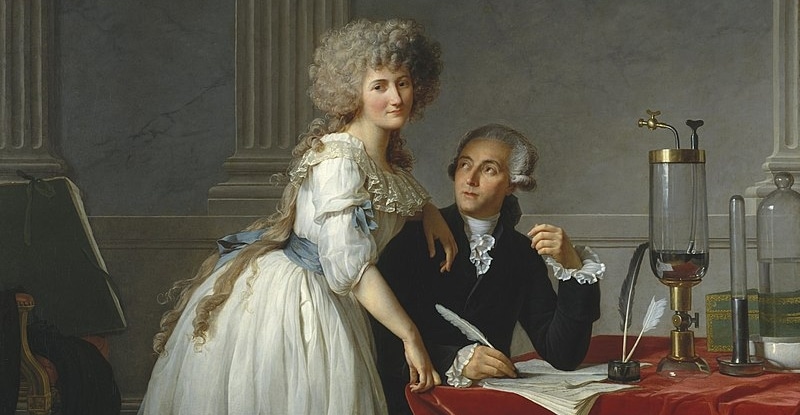The Lavoisiers: a couple of geniuses

Antoine Lavoisier and his wife, Marie-Anne, modernized science with new discoveries for the age, such as proving that four natural elements (water, earth, wind, and fire) were composed of atoms and molecules. But they didn’t stop there.
Let’s take a closer look at the history of these two chemists whose work together astonished many scientists around the world.
The young Lavoisiers
Antoine Lavoisier
Antoine-Laurent de Lavoisier was born in Paris on August 26, 1743, into a wealthy family. He owed his noble title “de” to his father, who was, at the time, an adviser to the king. He lost his noble title in the French Revolution. Antoine studied at the Collège des Quatre-Nations, where he was able to cultivate his knowledge in a variety of disciplines. These included chemistry and natural sciences, for which Antoine had a real passion. Later, and complying with his father’s wishes, he began studying law, which he combined with learning science. He was eminently successful in his law studies, graduating in 1764. However, he would never appear in court.
A scientist at heart, he applied to the Royal Academy of Sciences, where he became a member in 1768. In 1770, he became a tax collector, a high administrative position that obliged him to put science to one side for several years. However, this led to his meeting his future wife, Marie-Anne Pierrette Paulze.
Marie-Anne Pierrette Paulze
Marie-Anne Pierrette Paulze was born in Montbrison (south-east France) in January 1758 into an upper-class family. She received a typical bourgeois education at the Convent of the Visitation, where she studied science and was passionate about drawing.
It was in 1771 that Antoine Lavoisier, aged 28, married Marie-Anne, then only 13 years old. Marie-Anne would play a crucial role in her husband’s career, who, even at that age, was already a promising young chemist.
The Lavoisiers partnership
Married for nearly 23 years, they decided to work together to combine their skills, each with their own specialist area. Antoine carried out the experiments. On the other hand, Marie-Anne made very precise sketches of her husband’s experiments and learned foreign languages (English, Latin and even Italian) to translate foreign scientific articles for Antoine and publish his research internationally.
The end of the Lavoisiers
During the French Revolution, Antoine Lavoisier and Jacques Paulze, Marie-Anne’s father, were jailed by the revolutionaries for being part of the (Fermier Générale) tax-collection office (an unpopular tax-collection agency). They were both sentenced to death and were guillotined on May 8, 1794. A complete tragedy for Marie-Anne, who then took up the fight to recover her husband’s property, confiscated by the revolutionaries. She died on January 10, 1836, in Paris.
The legacy of the Lavoisiers
- The Lavoisiers, through their various discoveries, influenced the development of chemistry worldwide. They laid the foundations of modern chemistry, especially by proving that four natural elements are composed of atoms and molecules.
- Antoine Lavoisier championed the use of the experimental method in chemistry, as opposed to the phlogiston theory, a now-abandoned theory used to explain the phenomena of combustion and oxidation. It came about when Lavoisier conducted his research on combustion. Once considered a single gas, Lavoisier proved that air was made up of nitrogen and another gas, which he called “oxygen”. His studies on oxygen demonstrated its role in plant and animal respiration. This discovery led him to conclude that water is composed of oxygen and another gas that he called “hydrogen”. This discovery led to an understanding of the phenomenon of corrosion called “oxidation” (particularly the formation of rust).
- He also confirmed the principle of conservation of mass. Through his experiments, he determined that the mass of the reactants (before a chemical reaction) remains equal to that of the substances produced (after a chemical reaction). It is a fundamental law applicable to all the sciences, known as “Lavoisier’s Law”, according to which “nothing is lost, nothing is created, everything is transformed”.
- Before Mendeleev formulated his periodic table, various scientists had previously done work on which the Russian chemist relied. Lavoisier was one of those scientists. He was the first to formulate a classification of chemical elements presented in tabular form in his famous book “Elemental Treatise on Chemistry Presented in a New Order and According to Modern Discoveries”. Thus, he contributed to the reform of chemical nomenclature by making it more systematic.
- Lavoisier was appointed a commissioner of Powders and Salpeters in 1775 and also worked on chemistry as applied to the military field. His work included improving the yields of saltpeter, a principal ingredient in gunpowder.
Lavoisier enabled the transition from chemistry that could be described as “Middle Ages chemistry” to a modern and revolutionary chemistry for the age. He also proved that working together can be fruitful. In his case, the involvement of Marie-Anne Pierrette Paulze was a determining factor in the image of the revolutionary scientist, which developed internationally.
Want to find out more about the history of the Lavoisiers? Visit Chimical, Groupe Berkem’s popular science Youtube channel!